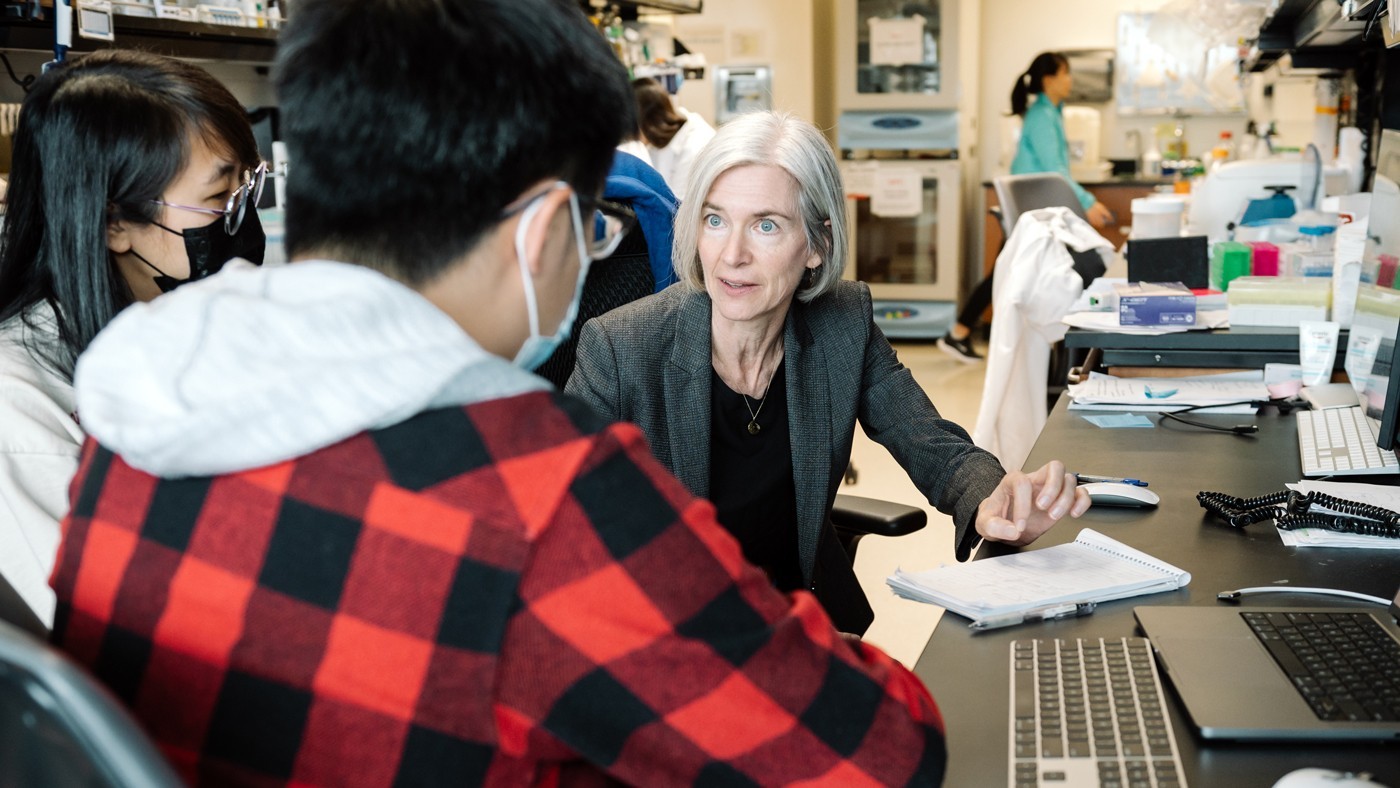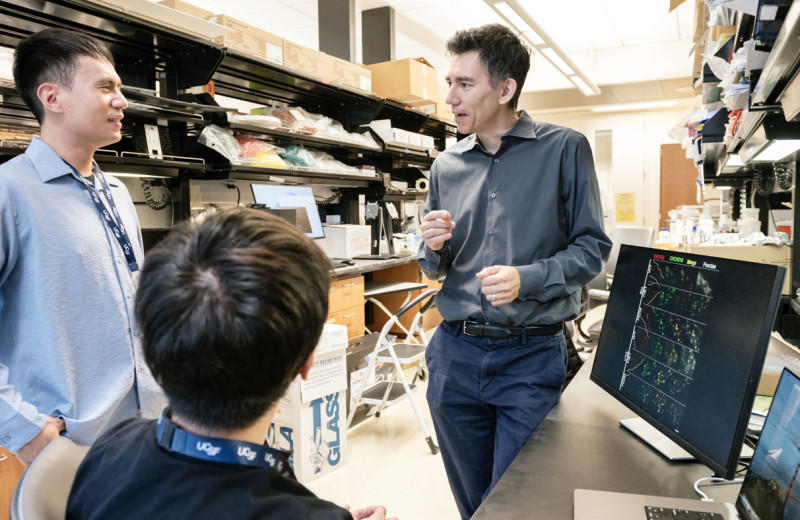Gladstone NOW: The Campaign Join Us on the Journey✕

Researchers at Gladstone Institutes leveraged CRISPR to target and rapidly destroy glioblastoma cells in an approach that could carry over to other highly mutated cancers. Seen here, Gladstone Investigator Jennifer Doudna (right) with I-Li Tan (far left), senior author of the study.
The gene-editing technology CRISPR shows early promise as a therapeutic strategy for the aggressive and difficult-to-treat brain cancer known as primary glioblastoma, according to findings of a new study from Gladstone Institutes.
Using a novel technique they’ve dubbed “cancer shredding,” the researchers programmed CRISPR to zero-in on repeating DNA sequences present only in recurrent tumor cells—and then obliterate those cells by snipping away at them. Working with cell lines from a patient whose glioblastoma returned after prior treatments, the team used CRISPR to destroy the tumor cells while sparing healthy cells.
“Glioblastoma is the most common lethal brain cancer, and patients still don’t have any good treatment options,” says Christof Fellmann, PhD, who led the study at Gladstone. “Patients typically receive chemotherapy, radiation, and surgery, but most relapse in a matter of months. We wanted to find out if we could do something outside the box that could get around this problem of recurrence.”
Finding the Hidden Code
Cancer treatments rarely kill all tumor cells. In glioblastoma, as with many other highly recurrent cancers, tumor cells that escape treatment develop multiple genetic adaptations, or mutations, that allow them to proliferate. Building from their earlier research, the Gladstone team surmised that these mutated cells have a unique genetic signature that could be targeted.
Using computational methods to analyze whole genomes of cancer cells, the team dove deep into the non-coding DNA to identify repetitive code all of them shared, even if they harbored a different variety of mutations. Then, armed with that data, they were able to guide CRISPR to the mutated cancerous cells and destroy them.
“We see CRISPR as a gateway to a new therapeutic approach that won’t be subject to the possibility of tumor cell escape,” Fellmann says. “Cancer shredding could hold potential not only for glioblastoma, but possibly for other hypermutated tumors.”
“We see CRISPR as a gateway to a new therapeutic approach that won’t be subject to the possibility of tumor cell escape. Cancer shredding could hold potential not only for glioblastoma, but possibly for other hypermutated tumors.”
The findings, in Cell Reports, are available online prior to being published in the November 28 print edition of the scientific journal. Much of the work was conducted in the lab of Gladstone Senior Investigator Jennifer Doudna, PhD, an author of the paper, who received the 2020 Nobel Prize in Chemistry for her co-discovery of the CRISPR-Cas9 gene editing technology. Also playing a key role in the study was Mitchel Berger, MD, a neurosurgeon and director of the Brain Tumor Center at UCSF, whose team helped secure patient-derived cell samples that bolstered clinical relevance of the results, and Alexendar Perez, MD, PhD, a resident at UCSF who did much of the computational work.
A New Role for CRISPR
Until very recently, CRISPR has been used mainly in the development of therapies or as a valued research tool, but not as a treatment modality in itself. That changed in mid-November when UK regulators approved the first CRISPR-based therapy, which is designed to cure sickle cell disease and beta thalassemia. In the US, the FDA is expected to issue a decision on the same therapeutic approach in early December.
The team behind the new Gladstone study say much work is needed to advance their promising findings into a therapy that’s ready to be tested in patients. Among the remaining challenges are determining how CRISPR should be delivered to patients with glioblastoma, and how to ensure no unintended off-target effects.
But despite the unanswered questions, first author I-Li Tan, PhD—who completed the study as a postdoctoral researcher in Doudna’s Gladstone lab and focused on brain cancer as a PhD student—says she feels hopeful about a disease that has vexed scientists for more than a decade.
“We understand so much today about glioblastoma and its biology, yet the treatment regimens haven’t improved,” Tan says. “Now we have a precise way to target the cells that are driving the cancer, and we hope this may one day lead to a cure.”
For Media
Kelly Quigley
Director, Science Communications and Media Relations
415.734.2690
Email
About the Study
The paper, “Targeting the non-coding genome and temozolomide signature enables CRISPR-mediated glioma oncolysis,” was published online in the journal Cell Reports on November 1 and will appear in the November 28 print edition. In addition to Fellmann, Doudna, Berger, Perez, and Tan, authors are: Rachel Lew, Xiaoyu Sun, Alisha Baldwin, Yong Zhu, Mihir Shah.
The work was supported by the NIH/NIGMS Pathway to Independence Award (K99/R00 GM118909), NIH/NIGMS Maximizing Investigators’ Research Award (ESI R35 GM143124), a UCSF Brain Tumor SPORE CEP Award, a UCSF Brain Tumor SPORE DRP Award, and a generous gift from the UCSF Fishgold Hurwitt Brain Tumor Research Fund.
About Gladstone Institutes
Gladstone Institutes is an independent, nonprofit life science research organization that uses visionary science and technology to overcome disease. Established in 1979, it is located in the epicenter of biomedical and technological innovation, in the Mission Bay neighborhood of San Francisco. Gladstone has created a research model that disrupts how science is done, funds big ideas, and attracts the brightest minds.
Featured Experts
Support Discovery Science
Your gift to Gladstone will allow our researchers to pursue high-quality science, focus on disease, and train the next generation of scientific thought leaders.
Six Gladstone Scientists Named Among World’s Most Highly Cited Researchers
Six Gladstone Scientists Named Among World’s Most Highly Cited Researchers
The featured scientists include global leaders in gene editing, data science, and immunology.
Awards News Release Corces Lab Doudna Lab Marson Lab Pollard Lab Ye LabThe Genome Editing Playbook Is Different in Neurons
The Genome Editing Playbook Is Different in Neurons
The striking findings of a new study could influence how gene therapies are designed for many genetic diseases.
News Release Research (Publication) Neurological Disease Conklin Lab Doudna Lab CRISPR/Gene EditingEvidence Builds for Disrupted Mitochondria as Cause of Parkinson’s
Evidence Builds for Disrupted Mitochondria as Cause of Parkinson’s
A new study from Gladstone Institutes strengthens the links between energy breakdown in cells and the onset of Parkinson’s, potentially illuminating new paths for treatment.
News Release Research (Publication) Parkinson’s Disease Neurological Disease Nakamura Lab




